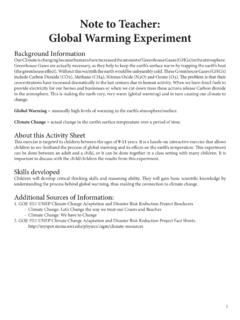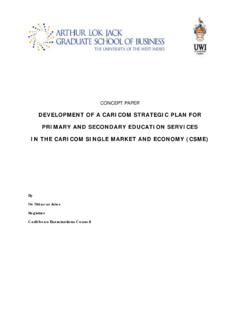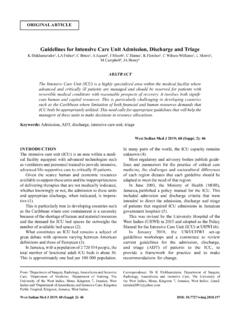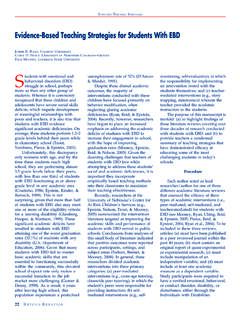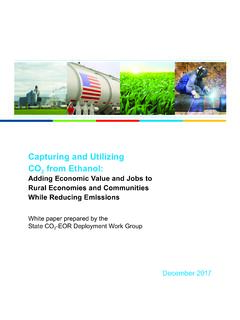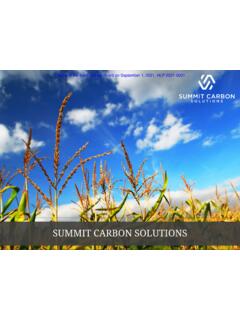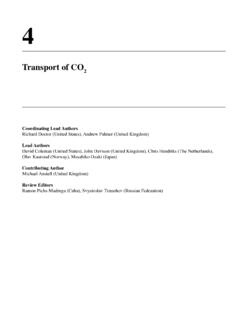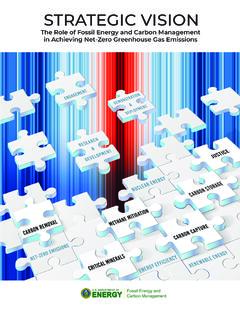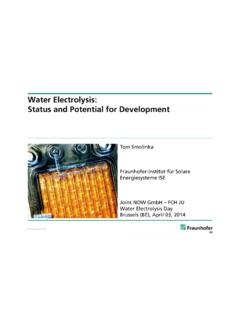Transcription of Introduction to Climate Change Mitigation
1 Workshop - The Science of Climate Change & Climate Change Vulnerability & Adaptation . Introduction to Climate Change Mitigation Climate Studies Group Mona (CSGM)- University of the West Indies. Institute of Meteorology of Cuba (INSMET). Presented by David Barrett ENBAR Consulting (MSc., MPhil.). Introduction to Climate Change Mitigation Content 1. Key Definitions. 2. Mitigation Potentials. 3. Emissions Trading. 4. Mitigation Options. Introduction to Climate Change Mitigation Aug-12 David Barrett 2. 1. Key Definitions. 2. Mitigation Potentials. 3. Emissions Trading. 4. Mitigation Options. KEY DEFINITIONS. Introduction to Climate Change Mitigation Aug-12 David Barrett 3. Key Definitions Climate Change : A Change of Climate which is attributed directly or indirectly to human activity that alters the composition of the global atmosphere and which is in addition to natural Climate variability observed over comparable time periods.
2 (UNFCCC Article 1.). Vulnerability: The degree to which a system is susceptible to, and unable to cope with, adverse effects of Climate Change (variability and extremes). Vulnerability is a function of;. Character of CC Sensitivity of environment. Magnitude of CC Adaptive capacity of the environment. Rate of CC & Climate variation. Introduction to Climate Change Mitigation Aug-12 David Barrett 4. Key Definitions Adaptation: Initiatives and measures to reduce the vulnerability of natural and human systems against actual or expected Climate Change effects. Types of Adaptation Efforts: Anticipatory and reactive. Private and public. Autonomous and planned. Mitigation : A human intervention to reduce the sources or enhance the sinks of greenhouse gases. (Glossary - IPCC Working Group I: The Scientific Basis).
3 Introduction to Climate Change Mitigation Aug-12 David Barrett 5. 6 Kyoto Protocol GHGs CO2 equivalent: The combined impact GHG's expressed in tonnes CO2. A tonne of carbon/ton CO2 can be an index for reduction or emission allowance. Introduction to Climate Change Mitigation Aug-12 David Barrett 6. PROCESS RELATED EMISSIONS 1. PROCESS EMISSION. CO2 CH4 N2O PFC SF6 HFC. Mineral Products Cement Production Lime Production 2. Limestone Use Soda Ash Production and Use 3. Fletton Brick Manufacture Chemical Industry Ammonia Nitric Acid Adpic Acid Urea Carbides Caprolactam Petrochemicals Metal Production Iron, Steel and Ferroalloys Aluminium Magnesium Other Metals Energy Industry Coal mining Solid fuel transformation Oil production Gas production and distribution Venting and flaring from oil/gas production Other Production of Halocarbons Use of Halocarbons and SF6.
4 Organic waste management Adaptation Vs. Mitigation Adaptation: Near term results. Focused action on adjustments of the recipient (physical and natural environment and biota) to reduce vulnerability and increase resilience to CC. No action taken towards influencing Climate systems. Anticipatory or reactive/responsive. Risk reduction strategies. Planning for long timelines. Generally developing countries will be impacted more and will need to implement greater adaptation. Policies and strategies vary by region, social groups, etc. Introduction to Climate Change Mitigation Aug-12 David Barrett 8. Adaptation Vs. Mitigation Mitigation : Premised on the precautionary principle . Preventative (proactive) or reactionary strategies to more dangerous anthropogenic interference of the Climate systems. May have defined timelines.
5 Developing, developed and industrial nations will have the greater influence on Climate systems. Will need to implement elevated Mitigation efforts. Targets the stabilization of GHG emissions but does not reduce the amount of GHG in the atmosphere nor reverse existing effects of Climate warming. Introduction to Climate Change Mitigation Aug-12 David Barrett 9. Adaptation Vs. Mitigation Stabilizing CO2 emissions at their present level would not stabilize its concentration in the atmosphere (Contribution of Working Group I, 4th Assessment Report). Introduction to Climate Change Mitigation Aug-12 David Barrett 10. Adaptation Vs. Mitigation Stabilizing the atmospheric concentration of CO2 at a constant level would require emissions to be effectively eliminated (Contribution of Working Group I, 4th Assessment Report).
6 Introduction to Climate Change Mitigation Aug-12 David Barrett 11. 1. Key Definitions. 2. Mitigation Potentials. 3. Emissions Trading. 4. Mitigation Options. Mitigation POTENTIALS. Introduction to Climate Change Mitigation Aug-12 David Barrett 12. Mitigation Potential Mitigation Potentials: Extent of the desired Mitigation which could futuristically be achieved over time. 1. Market Potential (assessment of potentials under forecast market conditions): Mitigation potential based on private costs and private discount rates (private investor and consumer driven). Potential based on facilitating policies and measures currently in place (state driven). Barriers to actual uptake (market/other driven). Introduction to Climate Change Mitigation Aug-12 David Barrett 13. Mitigation Potential 2. Economic Potential (assessment of potential based on social cost/benefit factors).
7 Mitigation potential which considers/includes social costs, social benefits and social discount rates. Assumes that market efficiency is improved by policies and measures and the removal of barriers. Social discount rates are lower than private investor discount rates. Studies of market potential can be used to inform policy makers. Assessed economic potential - generally greater than market potential. Introduction to Climate Change Mitigation Aug-12 David Barrett 14. Mitigation Potential 3. Technical Potential: (assessment of the extent to which possible GHG reduction or improved EE can be achieved using technology). Mitigation using a demonstrated technology or practice. Not defined by cost for the technology application. Economic considerations may be applied to allow for actual use. Introduction to Climate Change Mitigation Aug-12 David Barrett 15.
8 Mitigation Potentials Cost/benefit decisions should consider optimal outcomes of Mitigation . Biggest bang for the buck identify greatest impacts. Define the scope of the Mitigation efforts. Introduction to Climate Change Mitigation Aug-12 David Barrett 16. Main Types Of Emissions Sources Under Each Scope: SCOPE 1: DIRECT FUELS SCOPE 2: ENERGY SCOPE 3: OTHER. COMBUSTION INDIRECT INDIRECT (Discretionary). Fuel Combustion Consumption of Purchased materials and fuels ( Boilers, furnaces or purchased electricity, ( Extraction, processing and turbines). heat, steam and production). cooling. Owned transport Transport-related activities*. ( Trucks, trains, ships, ( Commuting, business travel, airplanes, cars). distribution). Process emissions Waste disposal ( Cement, aluminum, ( Waste, recycling). Waste processing).
9 Fugitive emissions Leased assets, franchising and ( Air conditioning and outsourcing. Refrigeration leaks, methane leaks from pipelines). Sold goods and services ( Use of Goods and services). (Source Defra Department of Environment Food and Rural Affairs, UK). Introduction to Climate Change Mitigation Introduction to Climate Change Mitigation (Source Defra Department of Environment Food and Rural Affairs, UK). 1. Key Definitions. 2. Mitigation Potentials. 3. Emissions Trading. 4. Mitigation Options. EMISSIONS TRADING. Introduction to Climate Change Mitigation Aug-12 David Barrett 19. Emissions Trading Elements of Recognized Mitigation Initiatives: Defined objective. Defined baseline or base case. Measurement system for deviations from baseline/base case. Reporting system. Verification system. Introduction to Climate Change Mitigation Aug-12 David Barrett 20.
10 NAMAs Nationally Appropriate Mitigation Actions (NAMA): Bali Action Plan ( , 2007). For Developing Country (DC) parties towards sustainable development, supported and enabled by technology, financing and capacity-building. 1. Unilateral NAMAs autonomous actions taken by DCs to reduce domestic GHGs (domestically funded and unilaterally implemented). 2. Supported NAMAs actions undertaken with financial, technological and/or capacity building support from developed countries. 3. Credit-Generating NAMAs actions that produce credits for sale in the global carbon market. (New Market Mechanism). Introduction to Climate Change Mitigation Aug-12 David Barrett 21. Low Carbon Development Strategies UNEP RESO. 2012. Introduction to Climate Change Mitigation Aug-12 David Barrett 22. Emissions Trading Carbon trading is a financial incentive driven mechanism to facilitate Mitigation .
